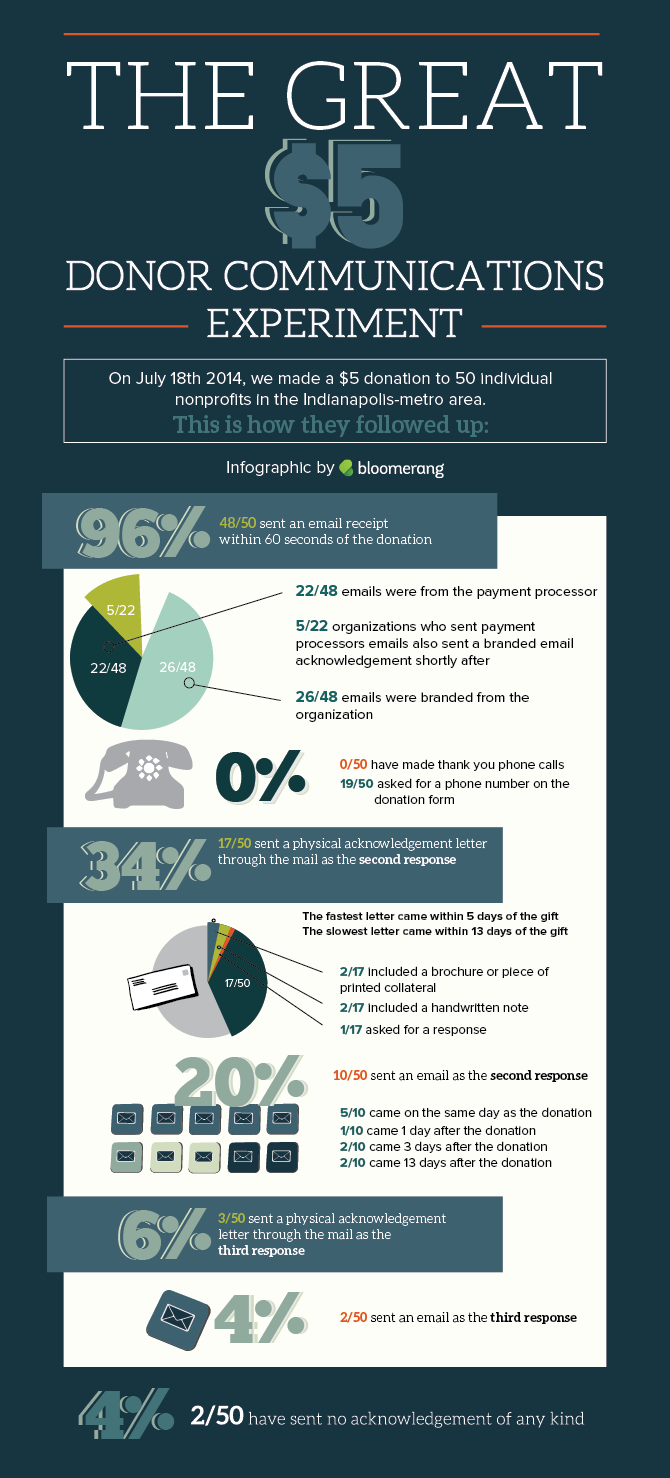If you’re not retaining as many donors as you’d like, you’ve no one to blame but yourself. And I’m here to tell you why.
You’re Not Thanking Donors Properly.
I’m serious. How you handle donor acknowledgements is that important. Yet, sadly, most of you do an absolutely rotten job of showing your donors how much they mean to you.
Part of the problem is due to focusing on acquisition at the expense of retention. Most executive and development directors don’t even know their retention rates without looking them up.
DUDES! Your retention rates should be on the tips of your tongues! If you don’t know how you’re doing, how can you improve?
If you’re the average nonprofit you’re retaining only 30% of first-time donors and 39% of ongoing supporters. AFP and The Urban Institute study revealed the depressing data. In other words, imagine you brought in 1000 new donors last year. Sounds good, no? But… those 1,000 will shrink to 300 this year. And to 117 in the next year. After five years you’ve got only 10 folks left. I’m NOT KIDDING! You’re on a treadmill. In and out. In and out.
Knowing your retention rate enables you to move it to something better. Did you know that a 10% increase in donor retention can increase the lifetime value (in dollars) of your donors by as much as 200%? This is research from Dr. Adrian Sargeant… plus Penelope Burk revealed this years ago in her groundbreaking “Donor-Centered Fundraising.”
Your first step in stoking your donor’s passion for your cause is assuring them they made a good decision when they made their first gift. Sending them an automated, impersonal receipt won’t accomplish this. Nor will waiting a week or more to acknowledge their gift.
Recently the good folks at Bloomerang conducted an experiment to see how 50 randomly selected nonprofits in the Indianapolis-metro area responded to their first-time $5 gifts. See the results in the accompanying infographic.
Wow! Pretty dismal response.
The results of this experiment prompted me to share a few of my most fundamental rules of charitable donation acknowledgments with you. There’s lots more to be said on the subject, but if you’re not doing at least the bare minimum you’re truly wasting your time even acquiring these donors. And I’m betting you can’t afford to waste your precious resources.
When I say bare minimum I don’t mean sending an automated receipt. That’s below the bare minimum in my humble opinion. No, here’s what the bare minimum requires:
You should be doing things with your thank you program that require some thought on your part. Plus, it should appear to the donor that you put some thought into your thank you.
Life corollary: Here you should know I’m not a fan of Hallmark cards sent simply with a signature. If you’re sending a card you should at least take the time to write something personal. Otherwise the message you’re sending is that you really couldn’t be bothered to think of something to say. The card was merely fulfillment of a chore. Chores are unpleasant, both for the sender and the recipient. The message received is exactly the opposite of the message intended.
Okay, let’s get to it. Some of my rules may seem over the top to some of you. If so, I want you to tell me what your donor retention rate is. If it’s not significantly better than the average, then you’ve got some changing to do. And if you change nothing else in your donor acknowledgement process, change these three things.
3 Rules for Thanking Nonprofit Donors that Should Never Be Broken
- Send a letter within 48 hours: This applies to all donors. I hate to see online donors treated differently than offline donors. In the Bloomerang experiment, only 34% sent a hard copy letter. I wonder if only 34% of offline donors got a letter in the mail. I certainly hope not! I also wonder whether the organizations taking 5 days or more to send a thank you letter were also taking that much time responding to someone who gave through “snail mail?” My guess is that offline donors get better treatment. (and I have an E-Guide on my Clairification website that shows folks how to accomplish the 48-hour turnaround). Don’t let your online donors suffer just because they chose to give via your website. Make sure they also receive a mailed thank you letter, with all your inserts and personal notes (which I’ll talk about below).
- Personalize your thank you with notes and inserts. It saddens me that so few nonprofits in the experiment took the opportunity to properly welcome their new donors to their community/family. Remember, a gift is the beginning of a budding relationship; not a singular transaction. For the relationship to blossom, give and take is required. Too many nonprofits are just “takers.” Be a “giver” and send a Welcome Packet with a few inspiring stories that reinforce the donor’s decision to invest with you. Also include information that lets folks know you welcome their involvement beyond just their monetary support (e.g., notices of upcoming events; invitation to a tour; volunteer opportunities). Then, put a personal note on the letter. Even if it’s just “Thanks for your support” in handwriting next to the signature, it’s a gesture showing you actually took some time signing the letter. It wasn’t all done by machine. I’ve tested this, and folks who receive personal notes renew at a much higher rate than those who do not.
- Pick up the phone. First, it seems pretty nutty that only 38% asked for a phone number. You want to be able to communicate easily with your donors folks! Not a single nonprofit of 50 called to thank the new Bloomerang donors. I know, you’re thinking it was just a $5 gift. Suppose it was a $100 gift. Would you call to thank then? If you’d ever given for the first time to any nonprofit for which I worked you’d have received a phone call (I always made sure first-time donors of $100+ got calls). We’d experiment making calls to a percentage of first-time donors below that amount, but never ended up with anything definitive showing this was worth/not worth the effort. Why? Staff got busy and didn’t follow through, thinking it wasn’t that important for these small donors. Right? Wrong? I challenge you to try this experiment for yourself. Not sure what to say? Pick up my free e-book on donor thank you calls when you subscribe to my blog . If you’re a small nonprofit, why not call every single donor? What better way to get to the point where you’ve too many donors to call all of them?!
Okay, that’s it. I want you to commit to doing this. You’re approaching that time of year when people feel the most generous. Before the donations start coming in, put a plan in place to thank these folks in a manner that will get them to give to you again.
- Prompt thank you.
- Mailed letter with personal notes and inserts.
- Phone call.
Remember that your prompt, personal thank you builds a bridge to future support and deeper engagement. Do it well, and you are on your way to future fundraising success.
The Power of Thank You Cannot Be Denied!
Learn all you need to know to increase your retention rates and improve the lifetime value of your donors with my upcoming 4-week E-Coursewith expert Pamela Grow: The Power of Thank You/The Basics and More! If you buy just one resource this quarter, buy this one. You get a TON of stuff — 4 complete Curriculum Guides + plenty of webinars, tutorials, podcasts, templates and more. Plus the wisdom of two different experts — Pamela and me. And it’s yours to download at your convenience and keep as a future reference! We’ve got plenty of practical tips to help you WOW your donors and keep them for life. Get it now – It will change the way you do fundraising, I promise! As with all Clairification products it comes with a satisfaction guarantee, or your money back.
Image courtesy of Freedigitalphotos.net









Hello,
How many donors were upset that you spent most of their $5 donation on the price of a stamp, the cost of paper, ink, etc. to thank them when they would probably be more happy if all the money went to their cause?? Did you take that poll, or consider it?
You don’t need to spend that much money on the thank you. And of course you never want to make your thank you look expensive. But most donors do want to be thanked, as born out in the extensive research done by Penelope Burk — which she has repeated more than once. If you’re concerned about this, you can include a check off box on your response device that indicates they would prefer an email thank you.